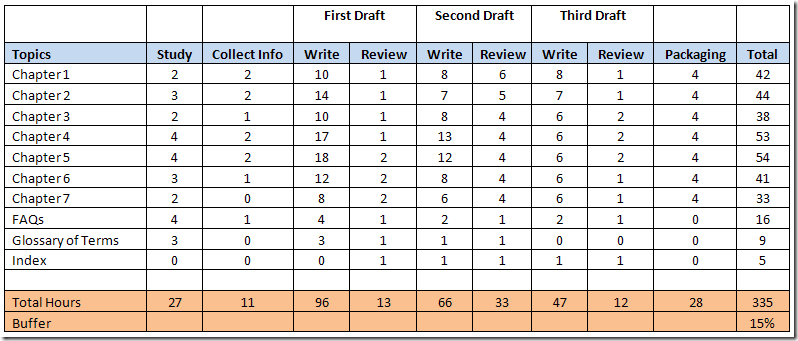This is the final essay of a three-part series. Read part 1 here and part 2 here.
In the previous article we talked about Ratio Analysis. We looked at
- Frederick Ratio or Height Ratio
- Sunil Ratio or Width Ratio
- Mak Ratio or Distribution Ratio
In this part we will look at two techniques of time estimation.
- Activity-based Matrix Technique
- Topic-based Spreadsheet Technique
Activity-based Matrix Technique
This technique is fairly simple to use. It is a simple table that you need to fill.
Activity-based Matrix Technique
| Draft 1 | Draft 2 | Draft 3 | Total | |
| Study Time | 12 | 0 | 0 | 12 |
| Writing Time | 80 | 60 | 22 | 162 |
| Review & Changes | 18 | 15 | 8 | 41 |
| Packaging & Release | 0 | 0 | 8 | 8 |
| Total | 223 |
This technique is applied when a quick estimate is required. For instance the client might show a demo and ask for a quick estimate within two hours. The writing process is broken down into the various activities. The process of writing the document can be split into 3 drafts. You can consider having more than three drafts depending on the scope of the document.
Estimate the time that will be taken for each activity corresponding to each draft.
Ideally, the time taken for the subsequent drafts will go on decreasing. If the time taken is constant for all drafts or the time taken increases for the subsequent drafts then there is considerable amount of discrepancy in the structure of the document.
If we consider the activities, not all activities will be part of the all three drafts –
- Study time – It will only be applicable to first draft
- Writing time – It is applicable to all drafts
- Review & Changes – It will be applicable to drafts 1 and 2. It may not be applicable to draft 3 (or final draft)
- Packaging & Release – This activity includes work like binding, printing, page numbering and so on. It obviously won’t be required for the first 2 drafts.
Use the Matrix technique to prepare Minimum (Best Case) and Maximum (Worst Case) estimates. The ideal estimate will be somewhere between these two numbers.
Topic-based Spreadsheet Technique
This technique is a much more advanced form of the Activity-based Matrix Technique. Here we use a slightly more advanced matrix. It is illustrated in the table inserted below.
Here we calculate the time for every activity at the chapter (or topic) level. You would get an accurate estimate if you use the RCO (Rich Content Outline).
Topic-based Spreadsheet Technique
Once you get your total number of hours, you add a buffer to it. Typically, this could be around 15% to 25%. This should give you an estimated number of hours for the project.
Estimating Project Cost
Once you have the number of hours you can prepare the cost estimate. For this you will need to multiply the number of hours by the hourly rate. Do not forget to account for the items like Communications, Travel, Cost of hours already spent and Hardware/Software (Other Costs.) This calculation should look like the Project Cost Estimation Table given here.
Project Cost Estimation Table
| Total Hours | 385 |
| Hourly Rate (in Rupees) | 200 |
| Person Hour Cost | 77000 |
| Communications | 1200 |
| Traveling | 4000 |
| Cost of hours already spent | 5200 |
| Other Costs (Hardware/Software) | 12000 |
| Total Price to be quoted | 99400 |
Change the hourly rates depending on the complexity of the work and experience level of the resource. Change the numbers mentioned to suit any currency.
There is a ready-to-use Excel sheet prepared by the author. To get a copy, please send a mail to the author.
The author has already published an article titled Estimating Documentation Projects. This article is available as a free-download on www.stc.org.
About the author:
Makarand (Mak) Pandit is a technical communicator/trainer with over 17 years of experience. Mak runs a Technical Writing & Training Company – Technowrites Pvt. Ltd. Mak can be reached at mak@technowrites.com
About the illustration:
Used with permission from Mallika Yelandur.



As always, very informative and nice piece. Thank you.